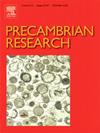Cooling and exhumation of the Jiao-Liao-Ji Belt: Evidence from multi-isotopic systems in-situ geochronology
IF 3.2
2区 地球科学
Q2 GEOSCIENCES, MULTIDISCIPLINARY
引用次数: 0
Abstract
The investigation of subduction-collision-exhumation processes in Paleoproterozoic orogenic belts is crucial to better understand the tectonothermal history of early plate tectonics. High-pressure mafic granulites in the northern part of the Jiao-Liao-Ji Belt, North China Craton, contain several varieties of datable minerals with different closure temperatures of U–Pb and Lu–Hf isotopic systems, providing an opportunity to explore the cooling and exhumation history of a Paleoproterozoic orogenic belt. The recorded ages of metamorphic zircon, garnet, titanite, and apatite are 1884 Ma, 1881 Ma, 1868 Ma, and 1801 Ma, respectively. Combined with isotopic closure temperatures, the final collision in the northern part of the JLJB is speculated to occur around 1880 Ma. The rocks then experienced relatively fast cooling (8.69–5.81°C/Myr) from 1880 to 1860 Ma, followed by slower cooling (4.01–3.15°C/Myr) till 1800 Ma. This two-stage exhumation is consistent with that observed in the southern part of the JLJB, although the initial exhumation is noticeably slower in the northern region. Compared to the cooling rates of modern orogenic belts, the lower cooling rates of Paleoproterozoic orogenic belts may imply a higher mantle temperature and a tectonic style significantly different from modern plate tectonics.
胶辽基带的冷却与发掘:来自多同位素系统的原位地质年代学证据
古元古代造山带俯冲-碰撞-掘出过程的研究对于更好地认识早期板块构造的构造热史具有重要意义。华北克拉通胶辽基带北部高压基性麻粒岩中含有多种具有不同U-Pb和Lu-Hf同位素系统闭合温度的可测矿物,为探讨古元古代造山带的冷却和挖掘历史提供了契机。变质锆石、石榴石、钛矿和磷灰石的记录年龄分别为1884 Ma、1881 Ma、1868 Ma和1801 Ma。结合同位素闭合温度,推测JLJB北部的最后一次碰撞发生在1880 Ma左右。从1880年到1860年Ma,岩石经历了相对快速的冷却(8.69-5.81°C/Myr),随后缓慢的冷却(4.01-3.15°C/Myr)直到1800 Ma。这两阶段的挖掘与在JLJB南部观察到的一致,尽管在北部地区,最初的挖掘明显较慢。与现代造山带的冷却速率相比,古元古代造山带的较低冷却速率可能意味着较高的地幔温度和与现代板块构造明显不同的构造样式。
本文章由计算机程序翻译,如有差异,请以英文原文为准。
求助全文
约1分钟内获得全文
求助全文
来源期刊

Precambrian Research
地学-地球科学综合
CiteScore
7.20
自引率
28.90%
发文量
325
审稿时长
12 months
期刊介绍:
Precambrian Research publishes studies on all aspects of the early stages of the composition, structure and evolution of the Earth and its planetary neighbours. With a focus on process-oriented and comparative studies, it covers, but is not restricted to, subjects such as:
(1) Chemical, biological, biochemical and cosmochemical evolution; the origin of life; the evolution of the oceans and atmosphere; the early fossil record; palaeobiology;
(2) Geochronology and isotope and elemental geochemistry;
(3) Precambrian mineral deposits;
(4) Geophysical aspects of the early Earth and Precambrian terrains;
(5) Nature, formation and evolution of the Precambrian lithosphere and mantle including magmatic, depositional, metamorphic and tectonic processes.
In addition, the editors particularly welcome integrated process-oriented studies that involve a combination of the above fields and comparative studies that demonstrate the effect of Precambrian evolution on Phanerozoic earth system processes.
Regional and localised studies of Precambrian phenomena are considered appropriate only when the detail and quality allow illustration of a wider process, or when significant gaps in basic knowledge of a particular area can be filled.
 求助内容:
求助内容: 应助结果提醒方式:
应助结果提醒方式:


